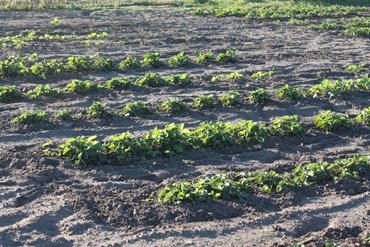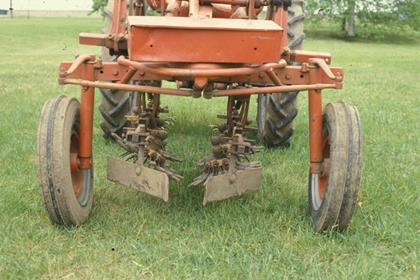New Strawberry Plant Care in the Field
Proper establishment of new junebearing strawberry plants in the field is critical to the success of the strawberry business. It is very easy to delay or omit the important cultural procedures involved in new field establishment, especially when older bearing beds begin to fruit. However, new plantings will have much greater productivity with sound establishment procedures. Longevity is a product of optimum plant densities, plant vigor and productivity and successful annual and perennial weed control. Up to a point, greater planting longevity will translate naturally to lower growing costs. The question of longevity, though, must be tempered with sustainable practices. If you plan on keeping a bed more than three fruiting seasons (my recommendation for long-term farm sustainability to prevent pest build-up and allow for possibly shorter rotations) then you should have sufficient land available to allow for longer rotation periods.
A short-term benefit of optimum first year plant establishment will be that the first bearing year yields and fruit size should be the best of the life of the planting. If your first year yields are not the best of any successive years, some cultural aspect was not addressed, assuming winter injury, spring frosts, or other stresses did not play a role. Although variables such as time of planting and initial plant spacing are very valid aspects of successful first year establishment, it is assumed that your actual planting date was four to six weeks ago. If you have not planted yet, all is not lost, but you will probably not have that first bearing year performance that growers would experience from planting in April or early May. The goal is to obtain the desired daughter plant pegged-down plant density by June 25th, so that they will eventually develop the optimum crown size/number and leaf mass by August 15th in order to initiate a maximum number of flower buds throughout the fall. Junebearing strawberries are short-day plants and as photoperiod (daylength) falls below 13 hours and temperatures cool, they start initiating flower buds for the crop next year.
Young, newly-planted junebearing strawberry plants will flower the first year; the objective is to prevent them from fruiting so they can divert their energy to vegetative growth. Flower removal is a critical step in establishment success to prevent young plants from becoming stunted, right at the time of year they should be growing the fastest. Depending on the crown size at planting, there may be from one to three inflorescences (flower scapes) that appear. In addition, if there was significant variability in plant grading size (one or more crowns per plant), there may be an even greater need to make multiple passes through the field in order to remove all of the inflorescences that might appear. They should be picked off as soon as they appear and never be allowed to get to the point where young fruit can be observed. Do not try to pinch or pull them off with one hand unless scissors are used; otherwise, stabilize the plant with one hand and remove the inflorescence with the other. Some growers purchase a tow-behind harvest platform that allows a blossom-picker to recline while cutting inflorescences instead of all that bending over…
The basic idea for fertilizing and watering young plants versus an established bed is that young plants should always have “less and more often” for both variables. Drip irrigation is ideal in that very low concentrations of fertilizers can be added at every watering, usually about 3-4 lbs of actual nitrogen/acre/week. Use a soil moisture sensor (measures soil moisture based on electrical resistance) or tensiometer in order to make informed decisions on soil moisture levels, and maintain between 50-65% of field capacity for optimum growth. If drip irrigation is not used on your farm, sprinkler irrigation should be applied with the same principles in mind.
Most fertilizing post-planting consists of nitrogen side-dressings (assuming that a soil test was taken and recommendations were duly followed for the less mobile nutrients). Common nitrogen sources include urea, potassium nitrate, calcium nitrate and ammonium sulfate. The ideal schedule should be 10-15 lbs of actual nitrogen per acre, every 2-3 weeks on sands and every 4- to 5-weeks on clays and loams. Typically, most growers end up applying fewer times, broadcasting 30 lbs actual nitrogen per acre 4- to 6-weeks post planting and two more applications of the same rates around July 15th and August 20th. In addition, a mid-September application of nitrogen to support flower bud formation later in to the fall can be very beneficial as strawberries can initiate flower buds in temperatures as low as 420F. Foliar feeding with a sprayer can work but I do not like this method because the extra trips across the field can cause compaction problems.
Growers can fine-tune a nutrition program by taking leaf tissue samples and having them analyzed. Remember that different labs have different recommendations on when to take samples for first year plants. Boron is a micronutrient that tends to be overlooked; it is quite mobile and needed for flower bud initiation and fruiting. It is applied at least once per year, and sands are most likely to be deficient.
Plant density and runner placement should be monitored on a regular basis. The optimum plant density depends on the cultivar as some cultivars have very large crowns, like ‘Valley Sunset’, while others have small plants/crowns, like ‘Glooscap’. A general guideline is that daughter plants should be 4-6″ apart. As soon as daughter plants have one to two fully-expanded leaves and strong root initials are showing, it is time to place and anchor the runners. In the past, when labor was not so expensive, growers would use hairpins to anchor the plants but just about anything will work, including a little soil mounding, rocks or whatever is available. Typically, plant density can become too high later on in the season and excess runners may need to be pulled to the aisles and cut off with coulters, a multivator, or hoe.

The actual row may also need to be narrowed, which should take place no later than September 20th, in order to allow the planting to recover before winter. Row width should not be allowed to widen past 18inches. The picture at right of plants in the foreground is about how they should look by the end of June.
Weed control is of utmost importance for the first year. Young strawberries have virtually no competitive ability when it comes to even small weeds. Some version of glyphosate is usually used to help prepare the bed for planting, especially if perennial weeds were a problem. Unfortunately, glyphosate does not take care of perennial weed seeds and does not always fully kill well-established perennials like quackgrass and field bindweed. It is always a good idea to scout for hot spots of perennial weeds and kill them with spot sprays, even if it means having to kill some strawberry plants in the process. Quackgrass rhizomes can spread over 50’ in one growing season if given a chance, so before you know it, one small hot spot can become a very large one by the end of the first year.

There are several herbicides that can be used in first year strawberry fields but my top pick is no herbicides. Even with herbicides labeled for first year strawberry weed control, there is a high likelihood that there is going to be a certain amount of negative effect on the strawberry plants also, even though labeled rates are typically carefully studied before a label is developed. Ideally, shallow mechanical weed control should be utilized. Running through the field with a Buddingh In-row weeder (shown in picture at left), multivator, basket weeders, rotary hoes or the like can do wonders when the weeds are still in the “white thread” stage and have not emerged yet. Shallow cultivation has the added advantages of less root damage to the young strawberry plants, and fewer weed seeds being lifted up to germination depth from lower in the soil profile. With the right mechanical equipment, it is surprising how little the old hand hoe has to actually be used and how significantly labor costs can be minimized. Once the plant-stand starts building up within row, straw can be used as an organic approach to control weeds within the aisles.
Some of the insect pests one could likely encounter in new plantings are potato leafhoppers, leafrollers, aphids and white grubs. One of the serious diseases that appears in new plantings is Verticillium wilt. There are a number of good IPM manuals available for pest identification and control recommendations. Once you accurately ID a pest, refer to the 2016 Midwest Fruit Pest Management Guide that can be downloaded free as a pdf. Strawberries can be a profitable and rewarding crop to grow but only if good cultural procedures are followed in the establishment year. Your efforts the first year will be multiplied many times in the future.
This article was posted in Berries and tagged Brian Smith, Strawberries.
